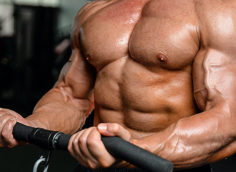The dumbbell bench press allows for a greater range of motion than the barbell bench press. And due to the use of two individual dumbbells, you're able to add a rotation as well.
Rotation should allow the main working muscle, the pectoralis major, to work over a greater range of motion. The muscle is lengthened in the bottom position and shortened in the top position. This greater range of motion stimulates more muscular hypertrophy.
What you see often though is people starting in the bottom position with the palms facing away from the body, similar to the position of the barbell bench press. When they press up, they rotate their arms so that the palms are facing each other in the end position. This isn't the best way to go.
The main functions of the pecs are to bring the arms forward and to internally rotate the arms. By starting with the palms facing away from the body and rotating the dumbbells so that the palms are facing each other, you externally rotate the arm, which is opposite to what you want. Instead of having the muscle maximally shortened and contracted in the end position, you "relax" the muscle at the top.
What's the Solution?
You could do the dumbbell bench press without any rotation. But if you want to add a rotation, start in the bottom position with the palms facing each other. Rotate on the way up so that the palms are facing forward in the end position, similar to the end position of the barbell bench press.





